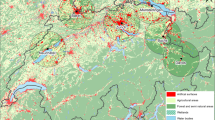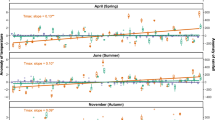Abstract
In light of heightened interest in the response of pollen phenology to temperature, we investigated recent changes to the onset of Betula (birch) pollen seasons in central and southern England, including a test of predicted advancement of the Betula pollen season for London. We calculated onset of birch pollen seasons using daily airborne pollen data obtained at London, Plymouth and Worcester, determined trends in the start of the pollen season and compared timing of the birch pollen season with observed temperature patterns for the period 1995–2010. We found no overall change in the onset of birch pollen in the study period although there was evidence that the response to temperature was nonlinear and that a lower asymptotic start of the pollen season may exist. The start of the birch pollen season was strongly correlated with March mean temperature. These results reinforce previous findings showing that the timing of the birch pollen season in the UK is particularly sensitive to spring temperatures. The climate relationship shown here persists over both longer decadal-scale trends and shorter, seasonal trends as well as during periods of ‘sign-switching’ when cooler spring temperatures result in later start dates. These attributes, combined with the wide geographical coverage of airborne pollen monitoring sites, some with records extending back several decades, provide a powerful tool for the detection of climate change impacts, although local site factors and the requirement for winter chilling may be confounding factors.





Similar content being viewed by others
References
Adams-Groom B, Emberlin J, Corden JM, Millington W, Mullins J (2002) Predicting the start of the Betula pollen season at London, Derby and Cardiff, United Kingdom, using a multiple regression model, based on data from 1987 to 1997. Aerobiologia 18:117–123
Andersen TB (1991) A model to predict the beginning of the pollen season. Grana 30:269–275
BAF (1995) Airborne pollens and spores: a guide to trapping and counting. The British Aerobiology Federation, Aylesford
Beggs PJ (2004) Impacts of climate change on aeroallergens: past and future. Clin Exp Allergy 34:1507–1513
Cannel MGR, Smith RI (1986) Climatic warming, spring budburst and frost damage on trees. J App Ecol 23:177–191
Corden J, Stach A, Millington W (2002) A comparison of Betula pollen seasons at two European sites; Derby, United Kingdom and Poznan, Poland (1995–1999). Aerobiologia 18:45–53
Cramer W, Bondeau A, Woodward FI, Prentice IC, Betts RA, Brovkin V, Cox PM, Fisher V, Foley JA, Friend AD, Kucharik C, Lomas MR, Ramankutty N, Sitch S, Smith B, White A, Young-Molling C ( 2001) Global response of terrestrial ecosystem structure and function to CO2 and climate change: results from six dynamic global vegetation models: Global Change Biology 7:357–373
Croxton PJ, Huber K, Collinson N, Sparks TH (2006) How well do the central England temperature and the England and Wales precipitation series represent the climate of the UK? Int J Climatol 26:2287–2292
Emberlin J, Savage M, Woodman R (1993) Annual variations in Betula pollen seasons in London 1961-1990. Grana 32:359–363
Emberlin J, Mullins J, Cordon J, Millington W, Brooke M, Savage M, Jones S (1997) The trend to earlier birch pollen seasons in the UK: a biotic response to changes in weather conditions? Grana 36:29–33
Emberlin J, Detandt M, Gehrig R, Jaeger S, Nolard N, Rantio-Lehtimaki A (2002) Responses in the start of Betula (birch) pollen seasons to recent changes in spring temperatures across Europe. Int J Biometeorol 46:159–170
Emberlin J, Smith M, Close R, Adams-Groom B (2007) Changes in the pollen seasons of the early flowering trees Alnus spp. and Corylus spp. in Worcester United Kingdom 1996-2005. International Journal of Biometeorology 51:181–191
Erdtman G (1954) An introduction to pollen analysis. Chronica Botanica, Waltham, Mass
Estrella N, Menzel A, Krämer U, Behrendt H (2006) Integration of flowering dates in phenology and pollen counts in aerobiology: analysis of their spatial and temporal coherence in Germany (1992–1999). Int J Biometerol 51:49–59
Fitter AH, Fitter RSR (2002) Rapid changes in flowering time in British plants. Science 296:1689–1691
Frei T (1998) The effects of climate change in Switzerland 1969–1996 on airborne pollen quantities from hazel, birch and grass. Grana 37:172–179
Goudie A (1996) The nature of the environment, 3rd edn. Blackwell, London
Grime JP, Hodgson JG, Hunt R (1996) Comparative plant ecology. Chapman and Hall, London
Hegerl GC, Zwiers FW, Braconnot P, Gillett NP, Luo Y, Marengo Orsini JA, Nicholls N, Penner JE, Stott PA (2007) Understanding and attributing climate change. In: Solomon et al (eds) IPCC Climate Change 2007: The Physical Science Basis. Cambridge Univ. Press, Ch 9
Hickler T, Vohland K, Feehan J et al (2012) Projecting tree species-based climate-driven changes in European potential natural vegetation with a generalized dynamic vegetation model. Global Ecology & Biogeography (in press)
Hirst JM (1952) An automatic volumetric spore trap. Ann Appl Biol 39:257–265
Konijnendijk CC, Nilsson K, Randrup TB, Schipperin J (2005) Urban forest and trees. Springer, Heidelberg, pp 1–520
Kramer K (1994) Selecting a model to predict the onset of growth of Fagus sylvatica. J Appl Ecol 31:172–181
Latalowa M, Mietus M, Uruska A (2002) Seasonal variations in the atmospheric Betula pollen count in Gdansk (southern Baltic coast) in relation to meteorological parameters. Aerobiologia 18:33–43
Linkosalo T (1999) Regularities and patterns in the spring phenology of some boreal trees. Silva Fennica 33:237–245
Menzel A, Estrella N (2001) Plant phenological changes. In: Walther G-R, Burga CA, Edwards PJ (eds) “Fingerprints” of climate change—adapted behaviour and shifting species ranges. Kluwer Academic/Plenum Publishers, New York, pp 123–137
Menzel A, Sparks TH, Estrella E, Koch A, Aasa R et al (2006) European phenological response to climate change matches the warming pattern. Global Change Biology 12:1969–1976
METO (2004) 1971–2000 averages. Met Office, UK. http://www.meto.gov.uk/climate/uk/averages/index.html. Accessed 05 June 2012
Murray MB, Cannel MGR, Smith RI (1989) Date of budburst of 15 tree species in Britain following climatic warming. J App Ecol 26:693–700
Newnham RM (1999) Monitoring biological response to climate change: the potential role of aeropalynology. Aerobiologia 15:87–94
Parmesan C, Yohe G (2003) A globally coherent fingerprint of climate change impacts across natural systems. Nature 421:37–42
Parmesan C, Duarte C, Poloczanska E, Richardson AJ, Singer MC (2011) Overstretching attribution. Nature Climate Change 1:2–4
Pauleit S, Jones N, Garcia-Martin G, Garcia-Valdecantos JL, Riviere LM, Vidal-Beaudet L, Bodson M, Randrup TB (2002) Tree establishment practice in towns and cities - Results from a European survey. Urban For Urban Greening 1:83–96
Rodríguez-Rajo FJ, Frenguelli G, Jato V (2003) Effect of air temperature on forecasting the start of the Betula pollen season at two contrasting sites in the South of Europe (1995-2001). Int J Biometeorol 47:117–125
Root TL, Price JT, Hall KR, Schneider SH, Rosenweig C, Pounds JA (2003) Fingerprints of global warming on wild animals and plants. Nature 421:57–60
Root TL, MacMynowski DP, Mastrandrea MD, Schneider SH (2005) Human-modified temperatures induce species changes: Joint attribution. Proc Natl Acad Sci USA 102:7465–7469
Rosenzweig C, Karoly D et al (2008) Attributing physical and biological impacts to anthropogenic climate change. Nature 453:353–357
Siljamo P, Sofiev M, Ranta H, Linkosalo T, Kubin E, Ahas R, Genikhovich E, Jatczak K, Jato V, Nekovar J, Minin A, Severova E, Shalaboda V (2008) Representativeness of point-wise phenological Betula data collected in different parts of Europe. Global Ecol Biogeogr 17:489–502
Skjøth CA, Sommer J, Stach A, Smith M, Brandt J (2007) The long range transport of birch (Betula) pollen from Poland and Germany causes significant pre-season concentrations in Denmark. Clin Exp Allergy 37:1204–1212
Skjøth CA, Geels C, Hvidberg M, Hertel O, Brandt J, Frohn LM, Hansen KM, Hedegaard GB, Christensen J, Moseholm L (2008a) An inventory of tree species in Europe - an essential data input for air pollution modelling. Ecol Model 217:292–304
Skjøth CA, Sommer J, Brandt J, Hvidberg M, Geels C, Hansen K, Hertel O, Frohn L, Christensen J (2008b) Copenhagen - a significant source of birch (Betula) pollen? Int J Biometeorol 52:453–462
Skjøth CA, Smith M, Brandt J, Emberlin J (2009) Are the birch trees in Southern England a source of Betula pollen for North London? Int J Biometeorol 53:75–86
Skjøth CA, Smith M, Sikoparija B, Stach A, Myszkowska D, Kasprzyk I, Radisic P, Stjepanovic B, Hrga I, Apatini D, Magyar D, Paldy A, Ianovici N (2010) A method for producing airborne pollen source inventories: An example of Ambrosia (ragweed) on the Pannonian Plain. Agr Forest Meteorol 150:1203–1210
Smith B, Prentice IC, Sykes MT (2001) Representation of vegetation dynamics in modelling of terrestrial ecosystems: comparing two contrasting approaches within European climate space. Global Ecology and Biogeography 10:621–637
Sparks TH, Jeffree EP, Jeffree CE (2000) An examination of the relationship between flowering times and temperature at the national scale using long-term phenological records from the UK. International Journal of Biometeorology 44:82–87
Sparks TH, Jaroszewicz B, Krawczyk M, Tryjanowski P (2009) Advancing phenology in Europe’s last lowland primeval forest: non-linear temperature response. Climate Research 39:221–226
Spieksma FTM (1990) Pollinosis in Europe: new observations and developments. Rev Palaeobot Palynol 64:35–40
Spieksma FThM, Frenguelli G, Nikkels AH, Mincigrucci G, Smithius LOMT, Bricchi E, Dankaart W, Romano B (1989) Comparative study of airborne pollen concentrations in central Italy and the Netherlands (1982–1985). Grana 28:25–36
Spieksma FThM, Emberlin JC, Hjelmroos M, Jäger S, Leuschner RM (1995) Atmospheric birch (Betula) pollen in Europe: Trends and fluctuations in annual quantities and the starting dates of the seasons. Grana 34:51–57
Thackeray SJ, Sparks TH, Frederiksen M, Burthe S et al (2010) Trophic level asynchrony in rates of phenological change for marine, terrestrial & terrestrial environments. Global Change Biology 16:3304–3313
WMO (2010) WMO statement on the status of the global climate in 2009. World Meteorological Organization, report no 1055. Switzerland, Geneva, p 14
Ziska L, Knowlton K, Rogers CA, Dalan D, Tierney N, Elder MA et al (2011) Recent warming by latitude associated with increased length of ragweed pollen season in central North America. PNAS 108:4248–4251
Zwiers F, Hegerl G (2008) Climate change: attributing cause and effect. Nature 453:296–297
Acknowledgements
This work was partly funded by the Copenhagen Global Change Initiative (www.cogci.dk) and the Villum-Kann Rasmussen Foundation through a Post Doc grant to Carsten Ambelas Skjøth and a Royal Society of New Zealand (ISAT) grant to Rewi Newnham. Tim Sparks acknowledges the support of the Technische Universität München – Institute for Advanced Study, funded by the German Excellence Initiative. The authors would like to thank the National Pollen and Aerobiology Research Unit at the University of Worcester who provided the pollen counts, particularly all those staff who are actively involved in producing pollen count data. The authors are also grateful to the Environmental and Public Protection offices, Islington, who operate the pollen trap in North London, to Martin Kent for insightful comments on the manuscript and to Tim Absolom for drafting Fig. 5. Data on birch leafing were kindly supplied by the Woodland Trust.
Author information
Authors and Affiliations
Corresponding author
Rights and permissions
About this article
Cite this article
Newnham, R.M., Sparks, T.H., Skjøth, C.A. et al. Pollen season and climate: Is the timing of birch pollen release in the UK approaching its limit?. Int J Biometeorol 57, 391–400 (2013). https://doi.org/10.1007/s00484-012-0563-5
Received:
Revised:
Accepted:
Published:
Issue Date:
DOI: https://doi.org/10.1007/s00484-012-0563-5




